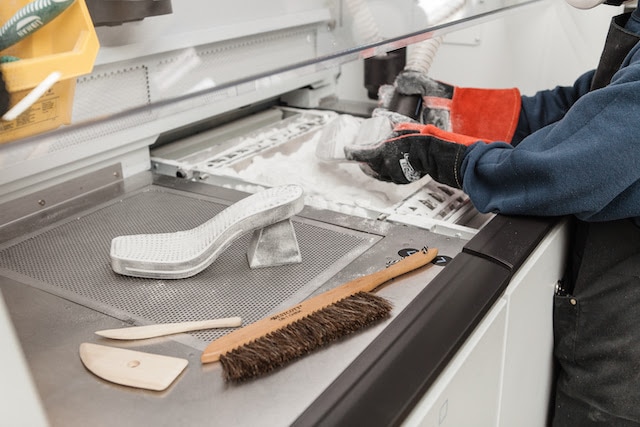How many shoes live in your closet? I stopped counting at 30 pairs, although in my defense, I’ve been wearing and repairing some of them for two decades.
Setting aside my questionable consumer habit, these official shoe stats are even more concerning: Of the estimated 20 billion to 24 billion pairs of footwear produced annually on a global basis, a significant number of them — potentially 95 percent — eventually walk their way into landfills. That number looms large for circular economy entrepreneur Elias Stahl, CEO and co-founder of three-year-old startup Hilos, which uses 3D printing technologies to produce the “platform” for shoes as they are ordered. (As Stahl tells it, the name “represents the versatility of the technology, from highs to lows.”)
Stahl, most recently vice president of products for social impact agency Handshake Partners, said he was motivated by the “insane amount” of waste he has observed in traditional manufacturing models. Many machines for shoe and apparel production, Stahl notes, haven’t been redesigned in a century — he describes them as “the last gasp” of U.S. product consumption models built on cheap overseas labor and a relative disregard for waste. “This is too big of a problem not to solve,” he told me.
Hilos, based in Portland, Oregon, in March raised $3 million in early funding for its process to rewrite the rules for shoe production using 3D printing technologies — a model already being used by shoemaker Helm to make bespoke mules that retail for $225 per pair. (Not exactly a mainstream offering.) Its investors include two former executives from Nike: Eric Sprunk, retired COO, and Greg Bui, retired vice president of global footwear sourcing and manufacturing. Both are actively engaged with Hilos, although Stahl is cagey about their exact involvement — Bui is leading “a rapid scale-up of the technology” (according to the company’s public statements) and Sprunk is an adviser.
Allure of additive manufacturing
Hilos is using 3D printing to change how the platform of a shoe — the part that bears the brunt of your personal footprint and, for that matter, the carbon one — is created. It doesn’t own the printers outright, instead, it partners with GKN Additive, using its facilities in California and Michigan, Stahl told me. Rather than being assembled from multiple layers glued or cemented together, the Hilos “printed” platform is created as one part that combines insole, midsole, outsole and heel. The “upper” of the shoe — in the case of the aforementioned mules, it’s veg-tanned leather — is attached using cables. According to Stahl, there are a number of benefits to this approach (the data is from an analysis referenced a bit later in this essay):
- The use of noxious glues is reduced, although it still uses about 1 gram per pair.
- The number of parts required can be dramatically reduced from an average of 65 to just five components per shoe. The number of steps required for assembly is reduced from 360 down to 12. That means it takes about an hour of labor to assemble rather than the typical estimate of four hours.
- The shoes can be produced “on demand” once they are ordered, cutting down on wasted inventory that never finds its way off the shelf.
- The shoes are easier to disassemble at the end of their wearable life.
Hilos teamed with the Yale University Center for Business and the Environment, BASF, HP and Additive Manufacturing Technologies to calculate the environmental impact analysis for its approach, which is the source for some of those claims. The startup also says its process can reduce the water consumption needed to produce a pair of shoes by up to 99 percent compared with traditional manufacturing, while reducing greenhouse gas emissions by 48 percent. About 29 percent of the CO2 reduction is related to parts reduction, 20 percent comes from switching to on-demand production and the rest comes from the product’s circularity, according to the analysis.
By the way, the evaluation specifically compared the Helm Emmett mule design with the Veja Esplar sneaker, with a fully leather upper.
One last thing to point out: If you compare the emissions of the two shoes on a part-by-part basis, the analysis suggests that the emissions for 3D printing are actually 10 percent to 17 percent higher. “Only when a complete assembly of the shoe is taken into account does the overall carbon efficiency of 3D printing stand out,” according to the analysis.
There’s another factor to take into account: What the Hilos platform is made out of. It’s not necessarily a material an audience of sustainability professionals readers would consider sustainable over the long term — the substance is a thermoplastic polyurethane powder from BASF. (Hence, BASF’s participation in the analysis.) When I asked Stahl if Hilos plans to use recycled or bio-based materials to create its shoe platforms, he said Hilos hopes to refine its production and disassembly approaches first.
Does Hilos represent a turning point for the use of additive manufacturing in the fashion industry? That’s clearly for brands to decide, as the startup pitches its approach — I can imagine it working mainly for some really specific footwear. But given those advising its business model, this startup is taking a step in the right direction.
Subscribe to AM Chronicle Newsletter to stay connected: https://bit.ly/3fBZ1mP
Follow us on LinkedIn: https://bit.ly/3IjhrFq
Visit for more interesting content on additive manufacturing: https://amchronicle.com


